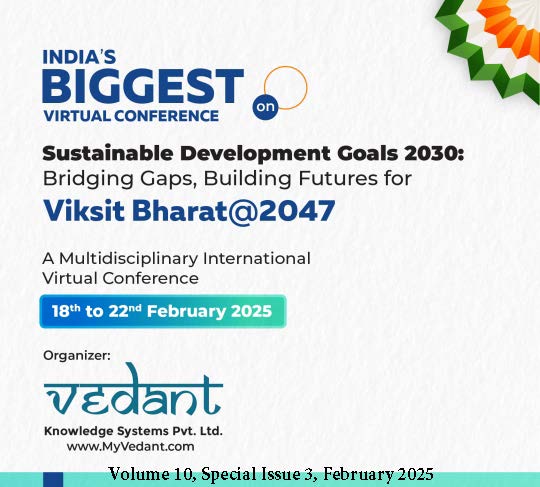Heartfulness Meditation Practice as a Tool to Balance Material and Spiritual Aspects of Life for Excellence in Work and Holistic Well-Being
DOI:
https://doi.org/10.58213/vidhyayana.v10isi3.2237Keywords:
Balance, Well-being, Meditation, Heartfulness, Heart Rate Variability (HRV)Abstract
Amidst numerous existential threats to humanity such as environmental degradation, climate change, and challenges to physical and mental well-being, it is time for critical reflection on whether we are adequately addressing both the material and spiritual dimensions of our existence. While we recognize the importance of a healthy body and sound mind, deep down in our hearts, we also acknowledge the essence of our being, our soul. Our soul, the higher presence within, sustains life and guides us if we allow it to do so. We are part of a unified whole. Quantum theory backs this spiritual truth when it gives the account of quantum entanglement and states that the world is not made of individual particles, rather, it is an inseparable whole. Just as nutritious food and exercise support the body, and intellectual pursuits enrich the mind, meditation is essential for nurturing the soul and aligning with universal consciousness. Heartfulness practice, supported by its unique feature of yogic transmission, nourishes the soul and harmonizes life’s material and spiritual dimensions, fostering balance and growth. Just as a bird requires both wings to soar, balancing these two aspects is crucial for reaching greater heights in both realms. Heartfulness philosophy is based on this principle and offers a set of practices that can be seamlessly incorporated into contemporary lifestyles. It is the modified form of Raj Yoga, the king among Yogas as truly expounded by the ancient seers of truth. While exploring the Heartfulness philosophy, the paper investigates its impact on neurophysiological parameters, demonstrating its effectiveness in inducing a relaxed and balanced state of being.
Downloads
References
Andrews, S., & Tayloe, J. (2015). HUMANITY’S CAPACITY TO SHARE A COMMON SENSE: THE ABSENCE THAT GIVES RISE TO OUR PRESENCE. ResearchGate, vol. 11(no. 2, 2015), 1–18. https://www.researchgate.net/publication/334050622-_HUMANITY
Arya, N. K., Singh, K., Malik, A., & Mehrotra, R. (2018). Effect of Heartfulness cleaning and meditation on heart rate variability. Indian Heart Journal, 70, S50–S55. https://doi.org/10.1016/j.ihj.2018.05.004
Bhave, V. (2019). Talks on the Gita. The Heartfulness Store.
Borthakur, R., Sharma, N., & Pattanaik, P. (2022). Predicting Calmness, Anxiety, and Depression using Wearable Sensors. https://doi.org/10.21203/rs.3.rs-1273712/v1
Bradley, R., McCraty, R., Atkinson, M., Tomasino, D., Daugherty, A., & Arguelles, L. (2010). Emotion Self-Regulation, Psychophysiological Coherence, and Test Anxiety: Results from an Experiment Using Electrophysiological Measures. Applied Psychophysiology and Biofeedback, 35(4), 261–283. https://doi.org/10.1007/s10484-010-9134-x
Childre, D., & Martin, H. (2011). The HeartMath Solution. Harper Collins.
Cranson, R. W., Orme-Johnson, D. W., Gackenbach, J., Dillbeck, M. C., Jones, C. H., & Alexander, C. N. (1991). Transcendental meditation and improved performance on intelligence-related measures: A longitudinal study. Personality and Individual Differences, 12(10), 1105–1116. https://doi.org/10.1016/0191-8869(91)90040-i
Davidson, R., & Lutz, A. (2008). Buddha’s Brain: Neuroplasticity and Meditation [In the Spotlight]. IEEE Signal Processing Magazine, 25(1), 176–174. https://doi.org/10.1109/msp.2008.4431873
Heartfulness: Practice. (2025). Heartfulness.org. https://heartfulness.org/en/heartfulness-practices/
INDICA. (2021, December 16). Effect of Heartfulness Meditation on Human Consciousness by Dr. Rajeshwari Hegde & Dr. Mohandas Hegde. YouTube. https://www.youtube.com/watch?v=JySMzsZt4bk
JMVRI: Journal of Maharishi Vedic Research Institute. (2021). Fullness of Life: The Foundations of Maharishi’s Science of Creative Intelligence. Academia.edu. https://www.academia.edu/49285298/Fullness_of_Life_The_Foundations_of_
Kamlesh D Patel, (Spiritual Master. (2019). Designing destiny: the heartfulness way. Westland Publications Private Limited.
Kaniamuthan, A. A. (2021). An in-depth understanding of heartfulness meditation. International E-Journal of Science, Medicine & Education, 15(2), 19–28. https://doi.org/10.56026/imu.15.2.19
Lagopoulos, J., Xu, J., Rasmussen, I., Vik, A., Malhi, G. S., Eliassen, C. F., Arntsen, I. E., Saether, J. G., Hollup, S., Holen, A., Davanger, S., & Ellingsen, Ø. (2009). Increased theta and alpha EEG activity during nondirective meditation. Journal of Alternative and Complementary Medicine (New York, N.Y.), 15(11), 1187–1192. https://doi.org/10.1089/acm.2009.0113
Malik, M., Bigger, J. T., Camm, A. J., Kleiger, R. E., Malliani, A., Moss, A. J., & Schwartz, P. J. (1996). Heart rate variability: Standards of measurement, physiological interpretation, and clinical use. European Heart Journal, 17(3), 354–381. https://doi.org/10.1093/oxfordjournals.eurheartj.a014868
McCraty, R., & Zayas, M. A. (2014). Cardiac coherence, self-regulation, autonomic stability, and psychosocial well-being. Frontiers in Psychology, 5. https://doi.org/10.3389/fpsyg.2014.01090
Miller, L. (2022). The Awakened Brain. Penguin Press.
Mukundananda, S. (2013). Bhagavad Gita: the song of God. Jagadguru Kripaluji Yog (Jkyog.
Patel, K. D. (2023). Spiritual Anatomy. Balance.
Patel, K. D., & Pollock, J. (2018). The heartfulness way. Westland.
Pearsall, P. (1998). The heart’s code: tapping the wisdom and power of our heart energy. Broadway Books.
Rollin Mccraty, & Institute Of Heartmath. (2015). Science of the heart: exploring the role of the heart in human performance. Heartmath Research Center, Institute Of Heartmath.
Russell, P. (2005). From science to God: a physicist’s journey into the mystery of consciousness. New World Library.
scienceandnonduality. (2014). Is Consciousness the Unified Field? John Hagelin. In YouTube. https://www.youtube.com/watch?v=LPhgDfT4Zpc
Shaffer, F., McCraty, R., & Zerr, C. L. (2014). A healthy heart is not a metronome: an integrative review of the heart’s anatomy and heart rate variability. Frontiers in Psychology, 5(1040). https://doi.org/10.3389/fpsyg.2014.01040
Takahashi, T., Murata, T., Hamada, T., Omori, M., Kosaka, H., Kikuchi, M., Yoshida, H., & Wada, Y. (2005). Changes in EEG and autonomic nervous activity during meditation and their association with personality traits. International Journal of Psychophysiology, 55(2), 199–207. https://doi.org/10.1016/j.ijpsycho.2004.07.004
Zohar, A. H., Cloninger, C. R., & McCraty, R. (2013). Personality and Heart Rate Variability: Exploring Pathways from Personality to Cardiac Coherence and Health. Open Journal of Social Sciences, 01(06), 32–39. https://doi.org/10.4236/jss.2013.16007
